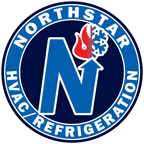Water Contamination in Ammonia Refrigeration Systems: Causes, Effects, and Solutions
Written by Ed Rice
Ammonia refrigeration systems are widely recognized for their efficiency and environmental benefits, but they are not without challenges. One of the common issues that can arise over time is water contamination in closed-circuit systems. While this might not sound like a major concern, the accumulation of water in ammonia refrigeration systems can lead to significant operational problems and efficiency losses if not properly addressed.
In this blog post, we’ll explore the causes of water contamination in ammonia systems, the adverse effects it can have, and the best practices for detecting, measuring, and removing water contamination to ensure optimal performance.
Causes of Water Contamination in Ammonia Refrigeration Systems
Water contamination in ammonia refrigeration systems can accumulate gradually and often goes unnoticed until significant problems arise. Some of the most common causes of water entering the system include:
Air Ingress: Water can enter the system when air leaks into the refrigeration circuit. This typically happens when there are small leaks in pipe fittings or valve seals, especially in areas of low-pressure suction lines.
Improperly Purged Systems: If the system is not properly purged during startup or maintenance, it can introduce moisture into the system.
Moisture in New Components: When new components such as valves, compressors, or heat exchangers are installed, they may contain moisture if they were not adequately dried before being integrated into the system.
Inadequate Maintenance: Poor maintenance practices, such as failing to regularly inspect and service equipment, can allow water to accumulate over time.
Adverse Effects of Water Contamination in Ammonia Refrigeration Systems
The presence of water in ammonia refrigeration systems can lead to various operational problems and inefficiencies. Here are some of the key issues caused by water contamination:
Reduced Compressor Efficiency: Water contamination can significantly affect the efficiency of compressors. Water reduces the refrigerant’s ability to cool effectively, leading to reduced capacity and higher energy consumption. Compressor capacity can drop dramatically, leading to longer run times and increased energy costs.
Corrosion: The formation of ammonium hydroxide (NH4+/OH-) due to the solubility of ammonia in water creates a corrosive environment. This solution can damage metal components within the system, leading to leaks, system failures, and costly repairs.
Inefficient Heat Transfer: Water contamination can form ice or slush within the evaporators, which reduces heat transfer efficiency. This can cause the system to work harder to achieve the desired cooling levels, increasing wear and tear on system components.
Higher Energy Costs: With the system’s overall efficiency compromised, you’ll experience higher energy costs as the system has to work harder to maintain required temperature levels. This translates to increased operating costs and reduced profitability.
System Damage and Downtime: If water contamination is not addressed, it can lead to serious system damage and unplanned downtime, resulting in costly repairs and potential product loss due to temperature fluctuations.
Detection, Measurement, and Removal of Water Contamination
Maintaining the integrity of your ammonia refrigeration system requires regular monitoring for water contamination. Here’s how you can detect, measure, and remove water contamination to maintain peak system performance:
Detection:
Ammonia Purity Testing: Regularly testing the purity of ammonia is essential to detect the presence of water contamination. This can be done by taking ammonia samples from the system and testing for water content.
Visual Inspection: Condensation on pipes or unexpected frost build-up can be visual signs of water contamination.
Measurement:
Hydrometer or Refractometer: These tools can be used to measure the concentration of water in ammonia, providing an accurate indication of contamination levels.
Compressor Performance Monitoring: A significant drop in compressor capacity may indicate that water contamination is affecting system performance.
Removal:
Purge Systems: Installing automatic or manual purging systems can help remove non-condensable gases, including water vapor, from the system. Regularly purging the system is key to preventing water build-up.
Dehydration Process: In more severe cases, the system may need to undergo a dehydration process, where water is physically removed from the system using specialized equipment.
Replacement of Contaminated Components: In some cases, particularly when corrosion has occurred, replacing contaminated parts may be necessary to restore the system to optimal operation.
Energy Savings from Water Removal
Removing water contamination from your ammonia refrigeration system not only improves performance but can also lead to significant energy savings. By ensuring your system operates at its peak efficiency, you can reduce the energy penalties associated with water contamination. This results in lower operating costs, extended equipment life, and fewer unplanned maintenance events.
Conclusion
Water contamination is a common issue in ammonia refrigeration systems, but with regular maintenance and proactive monitoring, you can prevent it from becoming a costly problem. By understanding the causes of water contamination and taking the necessary steps to detect and remove it, you can ensure the long-term efficiency and reliability of your ammonia refrigeration system.
At Northstar Refrigeration, we offer comprehensive maintenance services to help you keep your ammonia refrigeration system free from water contamination and operating at peak efficiency. Contact us at (508) 888-3692 to learn more about how we can help you safeguard your system and reduce energy costs.
(508) 888-3692
www.northstarhvacr.com
Edward Rice
Director of Marketing,
Northstar Refrigeration, Inc.
95 Camelot Drive, Unit 1,
Plymouth, MA 02360
erice@northstarhvacr.com www.northstarhvacr.com
p: (508) 888-3692 x115
m: (508) 561-8638



